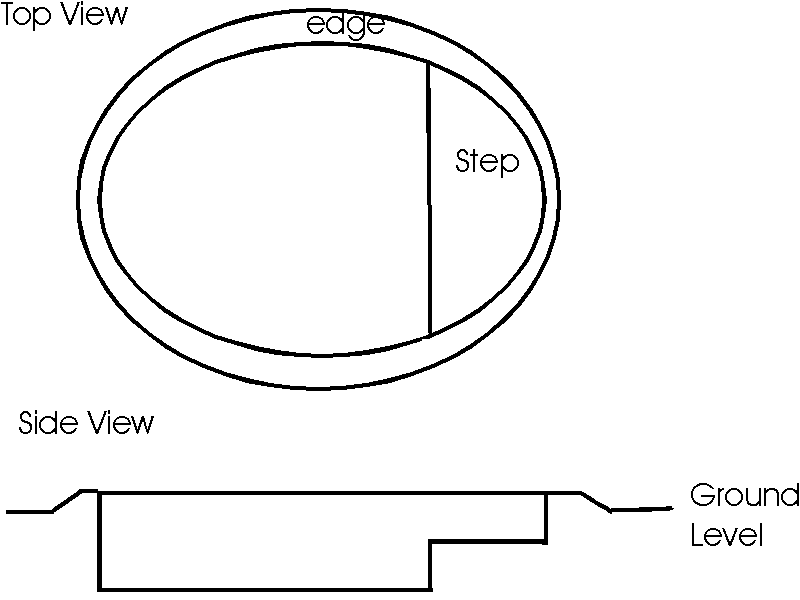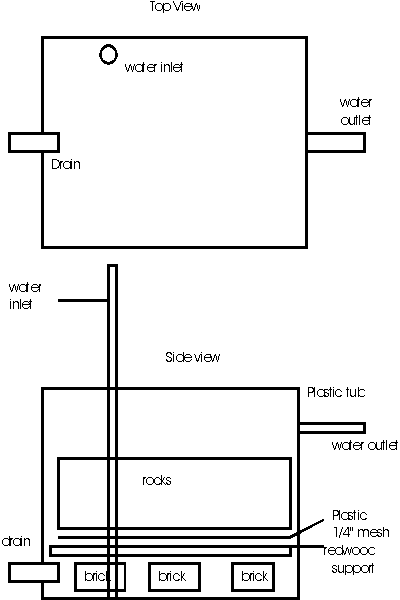| To bottom of page |
|
Top of page | ||||
HOME |
BEFORE |
INVESTMENTS |
TRAVEL |
WEB |
HOBBIES |
EXIT |
|
Fish Ponds
|

Introduction A nice fish pond in the yard is both a pleasure to see, and a retreat for the tired and weary. Your visitors will quickly take to the pond area, and will help you relax and enjoy life.
To make the experience the most enjoyable, the pond should be readially accessable and as work-free as posible. The following information shares my experiences and thoughts and should help you plan, construct, and operate your garden fish pond.
Picture
A picture is worth a thousand words, so here is a crude drawing of a typical fish pond. I will refer to this drawing in the discussions below.
Construction
Ponds are really quite simple and anyone can construct one with only
a minimum of time, effort and money. I will deal with an in-ground
pond, lined with a plastic or rubber medium but the bulk of the discussion
would also apply to an above-ground pond.
Below are several issues that should be considered before
undertaking this fun project.
Location
Location is important. First, the pond should be in a convenient location, one that you and everyone else enjoys being in. My main pond (I have two now) is located near the front walk, near the front porch; in plain sight of all our visitors and convenient for me too.Second, the pond should be located in shade if possible. This is in direct opposition to what you usually read. The real question is whether you are raising fish or plants. Lots of sun is good for plants, but generates too much algae. Algae will clog up your pump and filter system and make for lots of maintainence. There are plants that will help solve the algae problem, but why buy trouble when you don't have to.
Size
There are no rules as to fish pond sizes; just make the pond fit the location. It is a good idea however to make the pond as large as the area allows to prepare for future growth of your fish. Here are some "rules of thumb" to consider when designing the pond.
- Make the main area of your pond about 24 inches deep. This water depth will not freeze in the middle of winter if yo'all are south of the Mason-Dixon line. (Yankies need to go deeper, 36 to 48 inches)
- Some parts of the pond, around the edges, can be 12 to 18 inches in depth and 12+ inches wide to hold large pots of plants. See the ledge in the drawing above.
- A comfortable size pond is about 8 feet wide and 12 feet long. Bigger is always better, however the pond will have to fit the liner that you buy. The liner (usually PVC or rubber) is available at fish-pond specialty stores or at the local hardware (Lowes or Home Depot). Because of the sides and top-edge overlap, the liner must be six feet greater in width and six feet greater in length than the pond bottom.
Digging
Dig the hole for the pond with a slight inward slope on the walls. This will prevent the earth from sluffing off during construction and during the ponds life. Include some shelving around the pond for plants.Liner
I like PVC liner of about 20 to 40 mil thickness. It will last 10+ years and will not crack as some rubber liners do. For my 8 foot by 12 foot pond, the liner was 14 ft by 18 ft and cost about $200.Rock Edging
I like a sandstone or other rock edging around the fish pond to finish the outside. These rocks hold the top edge of the liner in place.Pump
For the pond size described above, a pump that puts out 500 gallons per hour is a good size. These pumps cost about $100 and will last about three to five years. The pump should be submerged in the deep end of the pond with the pump discharge and/or the filter discharge at the other end of the pond. The idea is to maximize the turnover of the pond water.Filter
I believe in biological filters but some people prefer mechanical filters; to each his own. My filters are "home made" from parts I bought at Wal-Mart and Lowes. They cost less than $25, as compared to $500+ for a comparable commercially available filter. The design is as follows:

- The body of the filter is a large plastic storage box, about 16" wide, 24" long, and 16" high. (Size isn"t critical, just make it as big as convenient, but, bigger is better.)
- All piping is PVC.The outlet is screwed together using rubber washers to make the joints water tight. The other PVC piping is put together with PVC glue.
- Inside the filter are the following components(from the
bottom up).
- About three bricks
- a grate made of redwood sticks, about one inch on centers
- A layer or two of 1/4 inch mesh plastic screen
- A six to eight inch layer of small rocks, ranging in sizefrom 1/2 to 1/4 inch.
- Water comes in the side of a 1 1/2 inch PVC pipe and falls to the bottom of the filter.As water falls in the pipe, it absorbs air for use in the biological degradation of wastes in the filter.
- Water leaves the filter by a side outlet overflow after passing through the rock bed.
- Monthly, the filter is backflushed by draining water out of the drain system at the bottom of the filter while putting fresh water on top of the rocks.
Plants Your plants and fish must match up. Koi will eat waterlilies like you and I would eat homemade icecream with chocolate sauce. For Koi, the following plants are OK.
- Louisiana Iris
- Umbrella Plant
- Horse Tail
- Any other tough aquatic plant
For goldfish and shubunkin, almost any water plant will be ok. My favorites are:
- Water Lily
- White snowflake
- Peacock fern
- All of those listed for Koi
- Biological filters need to be backflushed about once a month. If you are having an algae problem, then backflushing will occur more often.
- Pump suctions need to be kept clear. I enclose the pump in a plastic mesh box to keep out the plant roots and other junk.This needs monthly checking.
- Feed your fish all they will eat in about a five minute period. Do this one to three times a day, but minimize if you get excess algae growth.
- Let your plants cover the water surface and supply shade. Remove dead leaves, etc. as needed.
- Clean the bottom of the pond of leaves and trash once or twice a year. Don't work too hard at this. The fish like stuff on th bottom to root around in. This is the bottom.
Fish
Any new fish that you purchase must go through a period of isolation and treatment before going into your fish pond. If you don't do this, you run the very real probability of introducing a bad fish disease into the pond and killing all your present fish.
I use a 30 gallon plastic tank (a storage bin from Wal-Mart, $11) plus a tropical fishtank airpump to keep my new arivals in isolation for two weeks before going into the pond. I treat for "ick" as a minimum, using commercial medications available from Pet-Smart or any good fish store. Do it, you'll be glad you did.
Koi
The premier fish for any pond is the Koi. They are beautiful, smart, and live longer than most people (60 to 90 years). I have two males that are eight years old and they measure about 24 inches in length and weight more than five pounds. My younger fish are two years old and measure about ten inches and weight less than one pound. I had the misfortune of having two large and three medium sized Koi killed and eaten by a Great Blue Heron in the fall of '97. The bird was over four feet tall, with a wingspan near seven feet in length. He sure looked happy when he flew away. Many good pet stores have koi during the summer period. I buy the three to four inch size and patiently wait for them to grow. A typical small koi will cost about $5 to $10. Bigger fish quickly get to $50 to $100 each. There are lots of variation in color combinations for koi. I recommend checking your local library for information on the most desirable. I will put some information on this web page later, but not now.
Goldfish
I have one pond full of "Comet" goldfish. They are hardy and reproduce easially. These are a favorite for fish lovers. I often will buy "feeders" at the local pet store at 10 for a dollar and again wait for them to grow up. (Be sure to treat these fish well. They almost always have fish disease and you will loose more than half of them, at best.)
Shubunkin
These are really just fancy colored Comets, but well worth the difference. I like the fantail variety but the regular tailed fish is really beautiful (lots of red and blue colors).
Operation
Here is a short list of important maintainence items.
